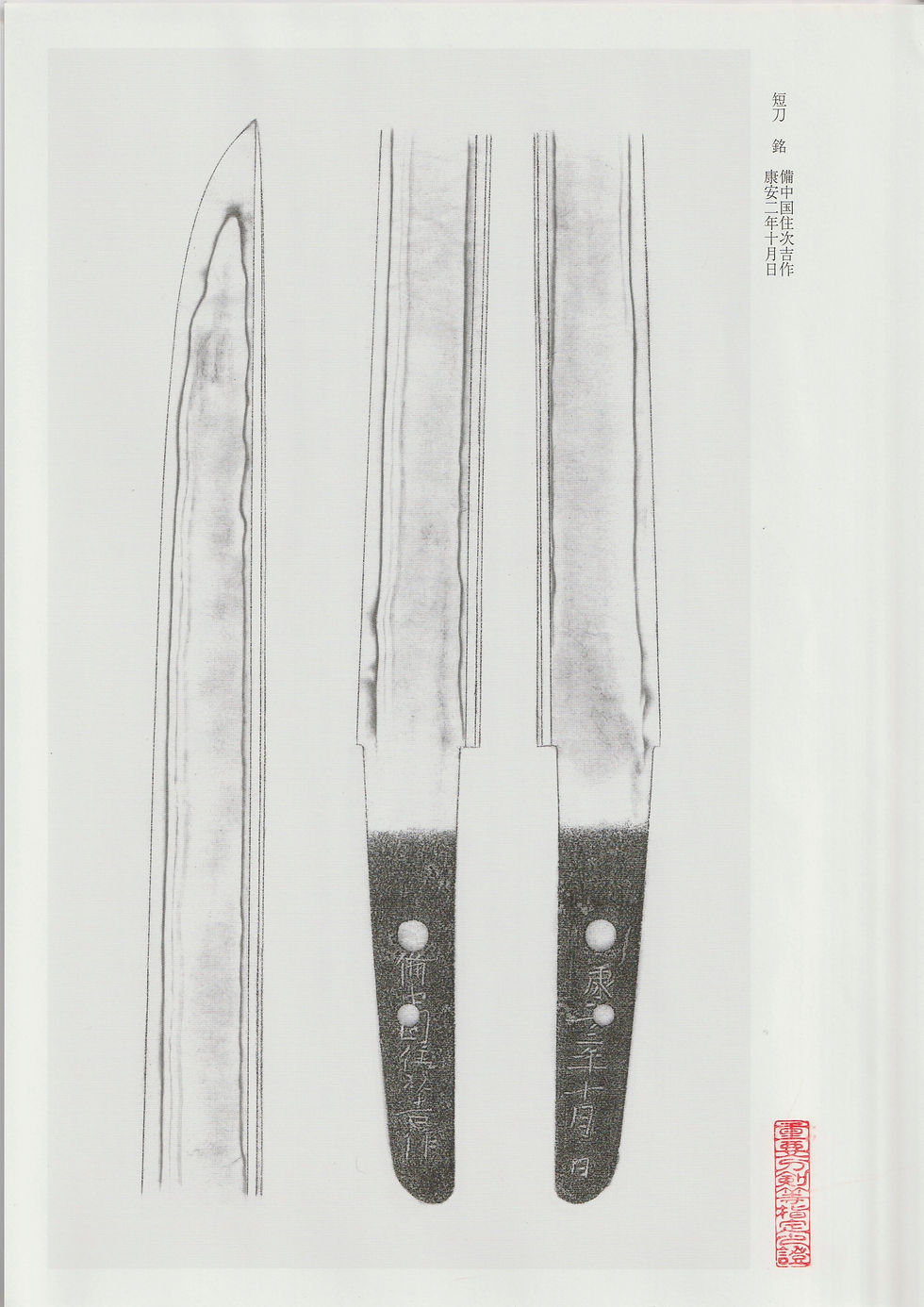2025 Dai Token Ichi (Part 1): Juyo Tanto by Bitchu no Kuni-ju Tsuguyoshi and Aikuchi Goshirae with Tomoe Mon in Gold Nashi-ji.
- gallery陽々youyou

- Oct 17
- 4 min read
We are pleased to announce our participation in the 2025 Dai Token Ichi, to be held on November 1–2 at the Tokyo Bijutsu Club. This year’s catalog features a tanto by Bitchu no Kuni-ju Tsuguyoshi (designated Juyo Token) with aikuchi goshirae with tomoe mon on a gold nashi-ji lacquer scabbard, and four Juyo fittings by Hirata Hikozo, Hayashi Shigemitsu, and Nobuie (hanare-mei and futoji-mei signatures).
Each of these works embodies the refined aesthetic of their respective masters. In this article, we introduce the tanto by Tsuguyoshi and its aikuchi goshirae.
Tanto by Bitchu no Kuni-ju Tsuguyoshi (Juyo Token)
This tanto is an Important Sword (Juyo Token) by Tsuguyoshi, a representative smith of the Aoe school in Bitchu Province during the Nanbokucho period.The following introduction draws from the explanation published in the 58th Juyo Token Zufu.
“In the early 11th century, “Shinsarugouki” (新猿楽記) listed ‘Bitchu no Kuni’ among the provinces known for producing fine goods. Swordsmiths of the Aoe school emerged as inheritors of that distinguished reputation, flourishing primarily along the lower reaches of the Takahashi River. Those of them up to the mid-Kamakura period are referred to as Ko-Aoe, while those from the late Kamakura to the Nanbokucho period are generally called Aoe. Characteristics of the ko-Aoe are known for small-nie tempering, tight nioiguchi, and bright, clear suguha or distinctive saka-choji. Tsuguyoshi’s works often feature suguha, while Tsugunao’s favor reverse choji-midare. Both exhibit tight nioiguchi and a bright, clear appearance—hallmarks of the school’s excellence.”
This tanto has a slender, refined form with a thin kasane. The forging is dense with fine ji-nie thickly appearing and ji-fu hada mixes in. Utsuri becomes dan-uturi. The hamon is bright suguha with strong and tight nioiguchi. The boshi shows notare. A representative work clearly exhibiting the distinctive characteristics of the Aoe school during this period. One of the most striking features of this blade is the boshi, which turns back deeply and boldly down all the way to the machi. This is unusual and rare among the suguha of the Aoe blades. Despite this bold execution, it retains refinement and elegance—an example of both technical skill and aesthetic restraint. Furthermore, this sword is signed and dated, greatly enhancing its historical and documentary value.
Specifications:
Length : 9 sun 1 bu (27.5 cm)
Sori (Curvature): Slightly inward (uchizori)
Period: Nanbokuchō period (14th century)
Kitae: The jihada is an itame with a flowing pattern, becoming somewhat prominent on the lower half of the ura. It shows very fine ji-nie, mixed with ji-fu. The bright utsuri appears, which turns into dan-utsuri near the blade.
Hamon: Narrow suguha with slightly notare-gokoro; occasional a bit of small ashi and saka-ashi appears; tight and bright nioiguchi with fine ko-nie
Nakago: Ubu (unaltered), two mekugi-ana; signed “Bitchū no Kuni-jū Tsuguyoshi saku”
Date (ura): Kōan 2 (1350), October.
This is a highly esteemed work that exemplifies the purity and brilliance of the Aoe tradition during the Nanbokuchō period.








Aikuchi Goshirae with Tomoe mon in Gold Nashi-ji Lacquer
The aikuchi goshirae features a gold nashi-ji lacquer scabbard adorned with scattered tomoe mon, exuding both elegance and noble sophistication.
It is believed to have belonged to the Uesugi family, as the registration number closely follows that of the celebrated Himezuru Ichimonji—a treasured blade of the Uesugi family. However, because this koshirae is not listed in the Uesugi-ke Okoshimono-chou (Inventory of Uesugi Family), the Jūyō Tōken Zufu commentary does not reference its provenance.
Although constructed in the aikuchi style, the kojiri (end of the scabbard) shows kiri (angular shape) and the narrow width of koikuchi and fuchi indicate that it predates the Momoyama period, when rounded kojiri shapes became the norm.
The gold nashi-ji lacquer is of early workmanship; the kōgai is an example of the early ko-kinkō work, while the kozuka is the Ko-Mino. The menuki depict a “nemuri shitei” (sleeping servant), a humorous and charming motif of a servant dozing off. The samegawa (ray skin) on the tsuka is coated with kuro-urushi (black lacquer) and pressed with silver foil, which has since aged to a deep patina, lending the piece a rich, time-honored character.
It is a mounting of remarkable aesthetic harmony and historical depth—one that rewards close study.






Infomation
At the 2025 Dai Tōken Ichi, gallery youyou will present this tantō and aikuchi goshirae, along with a wide selection of swords, katanagake, tosogu, and publications.
Event Details
Event: Dai Tōken Ichi 2025
Dates: November 1 (Sat) – 2 (Sun), 2025
Venue: Tokyo Bijutsu Club, 3rd Floor
Booth: gallery 陽々youyou (ギャラリー陽々)
Online Catalog: Click below button to access to the 2025 DTI catalog.


Closing thoughts
The combination of the tantō by Bitchū no Kuni-jū Tsuguyoshi and the aikuchi mounting with tomoe design in gold nashiji lacquer represents the pinnacle of harmony between the Japanese sword and its fittings. We invite you to experience in person the refined beauty and historical depth these works embody at 2025 DTI. In the next article, we’ll bring you a preview of “gallery youyou’s presentation at the 2025 Dai Token Ichi part 2.” Until then stay Tosogu and Sword Minded : )



Comments